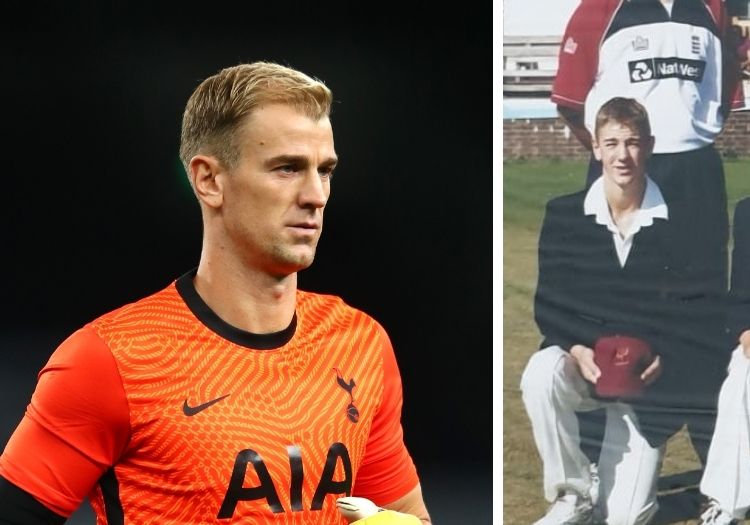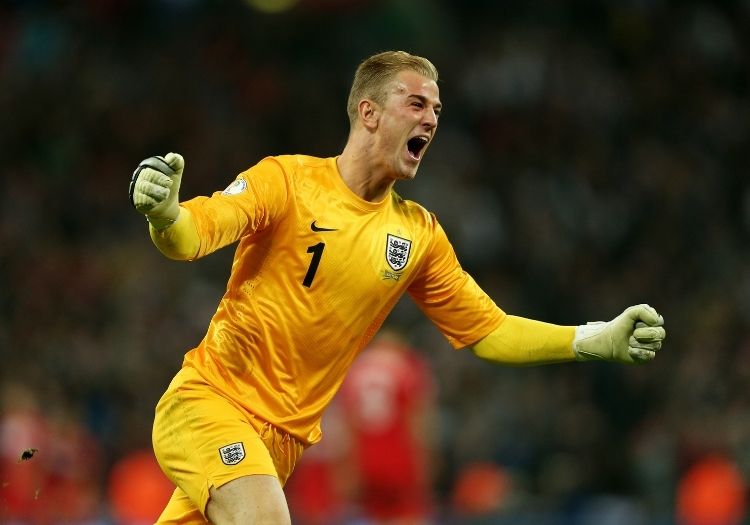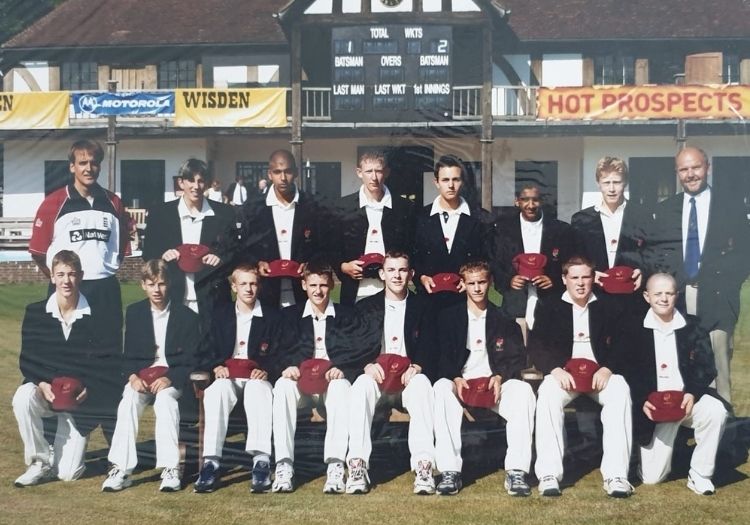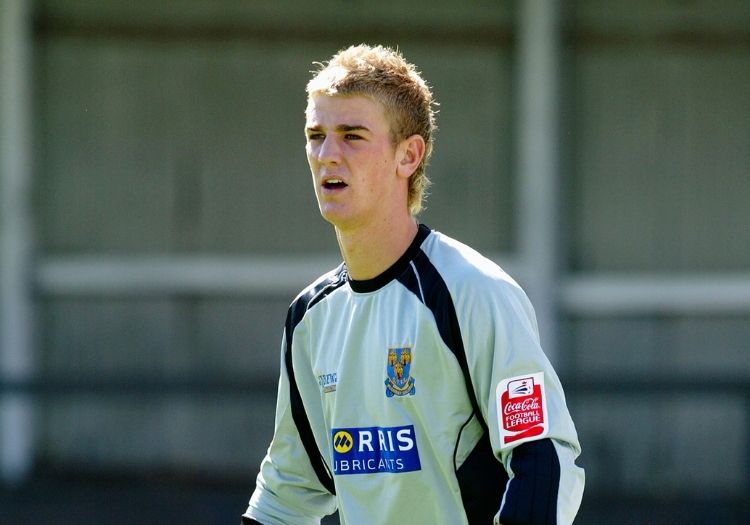NICK FRIEND: By the time Hart opted for football, his cricket credentials were well known: he had appeared twice at the Bunbury Festival, playing with Moeen Ali and against Adil Rashid. This is the story of an alternative career that never transpired

There was much to take in as Joe Hart ran in to bowl to Harry Kane at Hotspur Way, Tottenham’s state-of-the-art training facility – a picture that has, in the last week, captured the imagination of cricket fans across social media.
Dele Alli stood semi-interested at long-on; Gareth Bale was in at short midwicket; Matt Doherty hovered at extra cover; Sergio Reguilon, the club’s new Spanish left-back, looked on with a pleasing sense of baffled excitement; Eric Dier – clad in wicketkeeping gloves – barked some fairly impassioned encouragement in the direction of England’s second-most capped goalkeeper of all time, a left-arm seamer with a strong action who, after setting up Kane with three consecutive bouncers, cleaned him up with a delivery that clipped his off-bail.
Hart looked every inch a cricketer. Perhaps, because in another life, it was a road he might have taken.
As a teenager, he had choices to make and paths to follow. A photo once appeared in his local newspaper: Hart holding a football in one hand, a cricket ball in the other, wearing a pondering expression as he gazed into two alternative futures.
“He could have gone further, definitely,” says Jack Shantry, the former Worcestershire seamer who grew up playing alongside Hart at school and for Shrewsbury Cricket Club. “This isn’t with any faux humility, but he was a better cricketer than me at the same age. If he wanted to, he could have made it.”
Ed Foster, another teammate at club level and with Worcestershire’s academy, adds: “If he’d have carried on and had the glut of cricket that you can get if you want it from 17 through to 19 or 20, I’m sure he would probably have been in and around the England Under-19 setup – and who knows where he would have gone from there?
“He had all the raw materials, and where he’s got to in football shows he’s got enough between his ears to be able to put his physical aspects to good use. I’m sure he would have given himself an opportunity, for sure.”
And so, this is the story of a career that ultimately never took place. Hart would make his senior debut for Shrewsbury Town a day after his 17th birthday, having previously been an unused substitute while just 15 years of age.
By then, his cricketing credentials were already known; he had been part of national championship-winning sides at under-13 and under-15 level, while he had already appeared twice at the Bunbury Festival in 2001 and 2002 – the first time, playing a year above his age-group. “There wouldn’t be many kids who will have done that,” says David Parsons, his coach during those competitions and, more recently, England Cricket's performance director.

Joe Hart is joint as England's second-most capped goalkeeper, alongside David Seaman
“It wasn’t something that was spoken about, but when someone comes up from the age-group below and they take wickets in the age-group above, they’re always regarded as being good cricketers,” recalls Shaaiq Choudhry, a Bunbury teammate in Hart’s Midlands Under-15 side. “You automatically think that this guy must be a player.”
During those weeklong tournaments, featuring only the most promising young players in the English game, Hart counted Moeen Ali, Mark Footitt and Steven Davies as teammates. He played against future England internationals Adil Rashid and Joe Denly; among his wickets were Steven Mullaney and Karl Brown, both of whom would become stalwarts of the county game.
What sticks in the memory of both Choudhry and Parsons is the Hart-Footitt axis – two young left-arm seamers, both quick but also quite different in style.
They would each go on to enjoy successful professional careers, albeit, of course, in entirely different spheres. In the summer of 2015, while Hart was winning the Premier League’s Golden Glove, Footitt was called up to England’s Ashes squad and picked for a subsequent tour of South Africa.
“The slight difference with Footitt was that he was erratic and had real express pace at a young age,” Parsons explains, “and I don’t think that Joe was ever that top-end pace. But he was a little more skilful and he had his batting as well.
“Who knows? Who can predict at that age? But let’s say that he continued to develop, potentially he could have been somebody who delivered the ball in the mid-eighties, batted at No.7 and had a really decent head on his shoulders. Who knows what he could have achieved, certainly in county cricket, if not international cricket? He would have been one of those cricketers at 14 or 15 years of age, where you’d have said that he had a chance. You wouldn’t have bet against him making a career in cricket at that stage.”
"I think it was the one and only time I saw Joe cry - when he failed to hit the winning runs in a Kwik Cricket competition at Edgbaston"
By then, he was enrolled on Worcestershire’s academy programme. Damian D’Oliveira, the club’s late academy director, told the Sunday Mercury in 2008: “I am sure he would have been good enough to play county cricket. In fact, I think he would have been a very good county player.” It was only when Shrewsbury Town made him an offer during his final academy year that he made the decision to focus on football.
Choudhry would later play first-class cricket for both Warwickshire and Worcestershire, having come through the ranks at Derbyshire. His central recollection is of a net the pair enjoyed together after being left out of one Bunbury game. Instead, they were taken to the nursery ground at the Ageas Bowl, where they were filmed for an hour, providing footage for coaches on the ECB Level Three course to analyse.
“He was a good player and quite talented – it was evident that he could play,” he remembers. “He was a big lad for his age, and he was always tall. I was this tiny little guy; I hadn’t played with or against him before, so I didn’t really know who he was. He marked his run-up out and it was really long. I was batting and he was charging in.
“It was quite a bouncy deck and I remember just thinking as he was charging in that this guy was a good bowler. He had this pace, he generated good bounce and he really could bowl. I remember walking away from that net, thinking it was tougher than I thought it was going to be, considering he was a couple of years younger than me.”
Hart’s action took some honing, however. Foster recalls him going through a remodelling period. “I don’t think his action was particularly ‘safe’, as they would call it these days,” he explains. “So, while he has a strong action now, he went through quite a bit of work to get to that point in his mid-teens.”
In the clip shared by Tottenham on their YouTube channel, which has already been viewed more than half a million times, his teammates – at varying points – compare him to both Brett Lee and Mitchell Johnson.
To Hart’s credit, the Johnson parallels are not completely without merit – the tattooed sleeves, whippy arm and hostile lengths, even if his action is far more traditional than that of the Australian. Kevin Pietersen was impressed enough by the video to ask his substantial Twitter following: “Jeepers, who’s the left-arm seamer?”
Andrew Barnard, father of Worcestershire allrounder Ed, was Hart’s captain at Shrewsbury when he stepped into the first team as a mid-teen. Together with Ross Stephen, an Australian coach at the club, he had helped to shape Hart’s bowling.
“He was originally quite bent over, but we got him upright and we got him bowling quite quickly,” he says. “He would have been – if he’d carried on along that line – a very quick, aggressive left-arm bowler. He was a decent batter but, as you can imagine, his most spectacular quality was his fielding and his outfield catching.
“Because he was a competitor and a really bright competitor as well, I think he would have turned into a really good bowler. Through my experience, it’s very difficult to ascertain whether a big boy at 14 or 15 would go on to make it, but he had all the right credentials and the right attitude. Given the chance, I think he would have been a great professional.
“I think everybody knew in the club how dedicated, composed and athletic he was. And like everyone I know who’s gone on to play professional sport, he had a good head on his shoulders. He had all of those things that were working for him; he was easy to captain.”
"He would have been one of those cricketers at 14 or 15 years of age, where you'd have said that he had a chance. You wouldn't have bet against him making a career in cricket"
In short, he was a star – never more so than in age-group cricket at club level. When his Shrewsbury side won the national championships in 2000 and 2002, he was front and centre. In the under-15 final at Shenley, he took 3 for 19, before hammering 34 off 25 balls, batting at No.4.
He was one of an elite group, also including Shantry, captain James Gale and Rob Foster, Ed’s brother and – to this day – Hart’s agent and best friend. Gale, son of first-class umpire Steve, went on to play for Shropshire.
The Foster siblings, Hart, his sister Chloe and Shantry, whose brother Adam also played county cricket, all grew up within a stone’s throw from one another on an estate in Gains Park. A long drive into a cul-de-sac provided a perfect makeshift playing area.
“He was very fast for his age – certainly, in club cricket there were lots of batsmen who were scared of Joe,” Shantry laughs. “He had a very cunning slower ball, where he would pretend to grunt for his effort ball but then it would come out 20mph slower. Batsmen would be through the shot early and be caught at mid-on or bowled.
“He’d open the bowling and then bat at No.4 or No.5 and whack all the runs for us. When we won the under-13 title, I was a No.9 and a non-bowler. Joe was always the star of the side for us.”
Even by then, he had long-since established himself as a talented cricketer – and a determined competitor. Hart, Shantry and Rob Foster had played in the same under-11 team at Oxon Primary School that represented Shropshire in the finals of a national Kwik Cricket competition on the Edgbaston outfield.
“That was the start of our cricketing journey,” Shantry says. “Joe was batting in a pair with a girl called Jessica Johnson. He failed to hit the winning runs, and I think it was the one and only time I saw Joe cry – when he failed to hit the winning runs at Edgbaston.”

Hart (bottom left) lines up for his Bunbury Festival squad photo. It also features Choudhry (top row, second from right) and Steven Davies (bottom row, fourth from left)
They were coached through that tournament by former Yorkshire batsman Kevin Sharp, Shropshire Cricket’s development officer at the time.
“On the day, the whole school came,” Sharp recalls. “They cancelled school for the day and the head put on coaches and took the whole school to Edgbaston.
“I remember losing this one game and Joe was pretty much in tears – he was really upset. But what I recall of him at that age was a strong boy who was a very good all-round cricketer who bowled left-arm quick and was very lively for his age. You could see that potentially he had a future in cricket. I recall that day very vividly.”
Sharp never saw him after that and had no knowledge that his young fast bowler was – even as an 11-year-old – just five years away from the beginning of a totally different sporting journey. It was only while watching a game involving Manchester City that he heard the commentator mention his name.
“It’s quite a nice story actually,” he says. “I didn’t know he played football as well. I just knew him from cricket at Oxon Primary. So, many years ago when I’d left Shropshire and gone back up to Yorkshire, I was watching a match one day on television, and I heard this name: Joe Hart.
“I thought to myself: ‘I know a Joe Hart – from Oxon Primary School.’ But I never knew he was a footballer, so I sat down and watched. They passed the ball back to this blonde-haired goalkeeper and I thought: ‘God, that’s Joe, that’s Joe.’ I didn’t know he was a footballer. And there he was, in goal for Man City. I was just thinking: ‘God, this is unbelievable.’ I’d never known he played football.
“As a teacher or a coach, the one thing you enjoy is lads who you’ve worked with – in any shape or form – going on and doing well. You revel in that. Since I saw him in goal for Man City, I’ve obviously taken an interest in him.”
"He was very fast for his age - certainly, in club cricket there were lots of batsmen who were scared of Joe"
Sharp is not alone in his joy at what Hart has gone on to achieve. “I’m proud ultimately,” says Foster. “If you look back, we come from a very small part of the country in a rural town and the fact that the lad that used to live around the corner is jointly England’s second-most capped goalkeeper is pretty impressive really.”
Oxon Primary School has produced an England goalkeeper in Hart, first-class cricketers in Rob and Ed Foster, Jack and Adam Shantry and Worcestershire seamer Dillon Pennington, a Premiership rugby player in Graham Kitchener and a Team GB Olympian in judoka Daniel Williams.
“The estate that we grew up on isn’t a particularly affluent area but in a small area, there has been quite a lot of sporting talent to come out of it,” adds Shantry, who watched Hart make his Shrewsbury Town debut against Gravesend and Northfleet at Gay Meadow in 2004. A year later, his father bought Hart’s debut shirt in a charity auction.
“I’m incredibly proud when I watch Joe, and I wish him every success whenever I see him.”
It says a lot for all that Hart stands for that he remains so highly regarded by all those with whom he grew up. Then, he was just a child-goalkeeper with a burgeoning reputation and a cricketer with the potential to make a good go of it.
He has remained in touch with his local cricket club throughout; when Shrewsbury reached the final of a national competition a few years ago, Hart paid for a new set of coloured kit. His parents still live in the town.
“For all his wealth and notoriety, he’s treated like a lot of sportsmen who start at their club – he’s one of the lads who comes back,” says Barnard. “He’s very grounded and an important part of our development.”
In a remarkable quirk of fate, Hart was not even the first Manchester City goalkeeper to play cricket for Shrewsbury. During Barnard’s early playing days, Ken Mulhearn was a long-time teammate. At a time when footballers were able to spend their summers as they pleased in league cricket, he was a regular, having joined Shrewsbury Town via Everton and Manchester City. “He was a great wicketkeeper,” Barnard recalls. “He knew Joe as he grew up and they talked often.”
In the summer of 2018, while England were in World Cup action in Russia, Hart returned to his roots once more, turning out for Shrewsbury in a Birmingham Premier League game against Knowle and Dorridge for the first time since 2007. He didn’t bowl and only made six with the bat, but he took a catch in a winning draw.

Hart began his football career with Shrewsbury Town
Foster made 40 batting at No.3 and he remembers the occasion well. “It was during the World Cup, so he got a bit of grief for that, as ever,” he says. “But he was just keen to play – a lot of his mates are involved at the club and in the town.
“I think it was because he was in a bit of limbo between clubs at that point; while he was owned by Man City, it’s probably fair to say they weren’t that fussed about what he did.
“I know he was pretty nervous. He took a catch at one point that went fairly high up, and it was the kind that you’ve got a fair bit of time to think about. Equally, when he went out to bat, it was quite distinct actually. He played a brilliant cover drive which kind of just justified his inclusion, if you like. Any people who were watching and thought this was a bit of a stunt actually realised he had some ability. And then, he nicked off and I don’t think anyone appealed. He just walked.”
For Parsons, there are no lingering regrets at losing Hart to football, even if Tottenham’s videos have jogged his memory. As fate would have it, the young goalkeeper moved on loan in 2009 to Birmingham City, where Parsons watched on as a season ticket holder at St Andrew’s.
Hart, he explains, was one of three who faced similar decisions at the time. Keith Barker, who initially opted to sign for Blackburn Rovers rather than pursue a career with Lancashire, has since taken more than 500 professional wickets.
The other was Travis Binnion, “a really good wicketkeeper and a decent batsman” and a Bunbury teammate of Hart. He ultimately joined Sheffield United and played five times for Republic of Ireland Under-19. After an injury-enforced retirement, he is now an academy coach at Manchester United.
Parsons reflects: “Travis was the one I was almost most disappointed in because I thought, if he stayed in cricket, he could have gone furthest.
“But in those days, we didn’t have T20. It wasn’t quite such a sexy sport in terms of the razzmatazz or what might appeal to a young guy looking ahead. Maybe nowadays, with T20, the IPL, The Hundred and the Big Bash, it might appeal more to young guys of that age if they had to make that choice.”
Not that Hart appears ever to have lost the cricketing bug. And judging by last week’s antics, his ability hasn’t left him either.
Although, as Shantry says: “Seeing him play week in and week out in the Premier League, winning all those caps for England, playing at the Nou Camp for Manchester City, I’m not sure he’ll be thinking about playing at Wantage Road in front of 450 people.”
Gift a subscription to The Cricketer this Christmas and choose your free gift (a £20 John Lewis gift card or copy of Bob Willis: A Cricketer & A Gentleman). Subscribe here